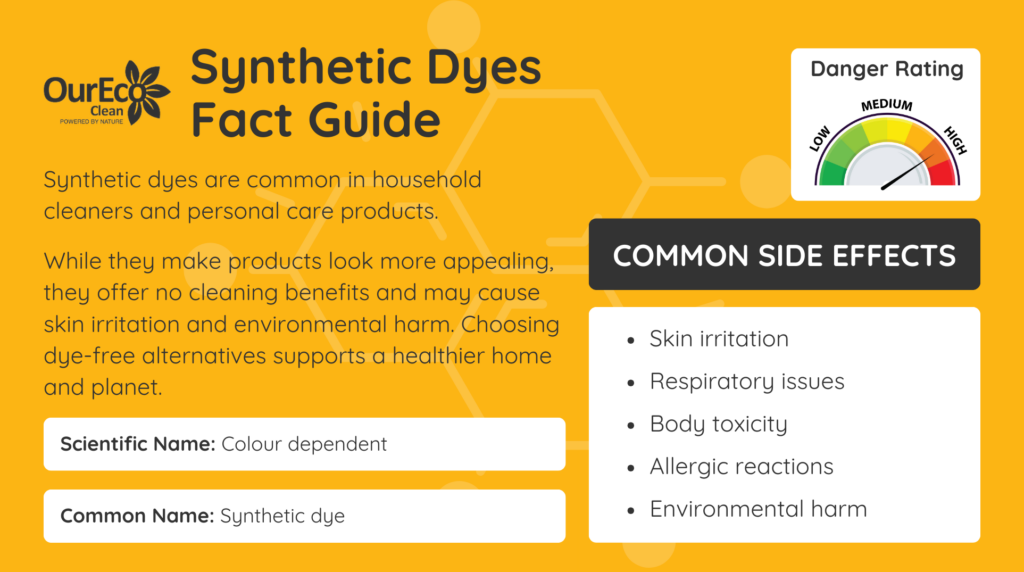Take a look at your cleaning supplies—are they bright blue, neon yellow, or vibrant green? While these synthetic dyes in eye-catching colours might make them look fresh and powerful, the truth is— they’re just for show. They don’t actually provide any cleaning benefits, and they might be doing you more harm than good.
Synthetic dyes are colourants added to products to make them more visually appealing. As a society, we’ve come to naturally associate different colours with cleaning effectiveness. Blue is often considered ‘fresh’, yellow as ‘citrus power’, and green as ‘nature’.
But as research develops, we begin to learn the unnecessary harm these synthetic dyes are adding to our cleaning regime. Let’s break down what synthetic dyes are, why they’re used, and how to avoid them in favour of safer alternatives. There’s no need to keep up appearances under the sink!

What are synthetic dyes?
Synthetic dyes are artificial colourants made from petroleum and coal tar derivatives (yes, you read that right—coal tar). Manufacturers use them in cleaning products to add colour, but they serve no functional purpose beyond making a product look good on the shelf.
Unlike natural pigments, synthetic dyes contain chromophores, which absorb and reflect light to produce intense colours, and auxochromes, which help dyes bond to surfaces. This is why a neon-coloured dish soap stays vividly green, wash after wash.
Synthetic dyes don’t break down easily either. This means they can linger in your home, on your skin and in the environment long after you’ve rinsed them away.
Why are synthetic dyes used?
Plain and simple—marketing. Synthetic dyes have long been used as a ploy to make products look more appealing. Vibrant colours can make us subconsciously associate a product with cleanliness or effectiveness, even though the dyes themselves do nothing to improve the formula’s actual cleaning ability.
Another reason companies may use synthetic dyes is to create consistency. Some natural ingredients can vary in colour, so manufacturers use dyes to ensure every bottle looks the same. While this might seem harmless, these unnecessary additives can contribute to skin irritation, allergies and environmental pollution.
Common cleaning products that contain synthetic dyes
If your cleaning solution has an unnaturally bright colour, there’s a good chance it contains synthetic dyes. Some of the biggest culprits include:
- Dishwashing liquids
- Laundry detergents
- All-purpose cleaners
- Toilet bowl cleaners
- Fabric softeners
- Air fresheners and scented sprays
These products are used daily and come into contact with your skin, your clothes and the surfaces in your home. That’s a lot of unnecessary exposure to artificial colourants.
Common side effects of synthetic dyes
Synthetic dyes might make cleaning products look good, but they don’t always play nice with your body or the environment. Many synthetic dyes are made with heavy metals and chemical compounds that can cause skin irritation and allergic reactions—especially in people with sensitive skin.
Some of the most common concerns include:
- Skin irritation: synthetic dyes are known irritants, especially for those with eczema, allergies or sensitive skin.
- Respiratory issues: certain dyes, particularly those in aerosol-based cleaning products, can trigger respiratory discomfort or exacerbate asthma symptoms.
- Potential toxicity: some synthetic dyes contain heavy metals like lead and arsenic, which are known to build up in the body over time.
- Environmental impact: synthetic dyes don’t break down easily, meaning they linger in waterways and can be toxic to marine life.
That’s why we’ve added synthetic dyes to our harmful ingredient list.
How to avoid synthetic dyes in your home
The easiest way to skip synthetic dyes? Check your labels. Many cleaning products will list dyes with names like FD&C Blue No. 1 or D&C Yellow No. 10—these are usually red flags. If a product is unnecessarily colourful, that’s another clue that it likely contains synthetic dyes.
Instead, look for dye-free or naturally coloured cleaning products. Many eco-friendly brands, like OurEco Clean, skip artificial colourants altogether, relying on plant-based or mineral-derived alternatives instead. This may mean the colour varies between batches, or the product has no colouring at all, but you’ll know it’s less likely to cause any irritation.
What are synthetic dyes doing to our environment?
It’s not just about what synthetic dyes do to your skin—they also impact the environment. Many synthetic dyes are resistant to biodegradation, so when they’re washed down the drain, they can stick around in waterways for years, polluting rivers and affecting marine ecosystems.
Some dyes can also be toxic to aquatic life, causing long-term damage to fish and other marine organisms.
What to use instead
The good news is you don’t need synthetic dyes to clean effectively. Many natural alternatives work just as well—without the unnecessary chemicals. Look for products that use:
- No dyes at all: the simplest and safest option.
- Plant-based or mineral-derived colours: some brands use botanical extracts or clays for a subtle, natural tint.
- Essential oils: not only do they provide a natural fragrance, but some (like citrus and eucalyptus) can also add a light tint naturally.
A healthier home starts with OurEco Clean
A truly clean home isn’t just about what you scrub away—it’s about what you bring in. Avoiding synthetic dyes is one small but impactful step toward a healthier, more eco-friendly home.
When shopping for cleaning products, take a moment to check the ingredients before you ‘add to cart’. Our range of eco-friendly cleaning solutions is a great place to find safe products for your home.
